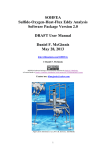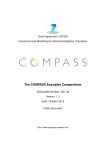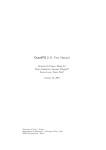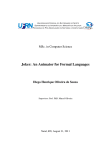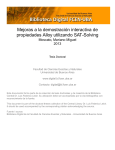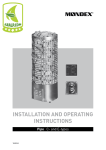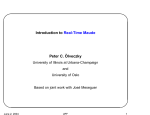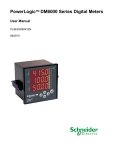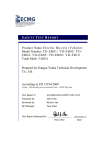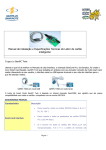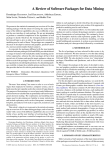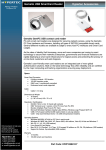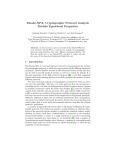Download Formal Refinement Support
Transcript
Grant Agreement: 287829
Comprehensive Modelling for Advanced Systems of Systems
Formal Refinement Support
Technical Note Number: D33.4
Version: 1.00
Date: September 2014
Public Document
http://www.compass-research.eu
D33.4 - Refinement Support (Public)
Contributors:
Simon Foster, UY
Alvaro Miyazawa, UY
Editors:
Simon Foster, UY
Alvaro Miyazawa, UY
Reviewers:
Jan Peleska, UB
Zoe Andrews, Newcastle
Luı́s D. Couto, AU
2
D33.4 - Refinement Support (Public)
Document History
Ver
0.01
0.02
0.03
0.04
Date
11-07-2014
23-07-2014
15-08-2014
28-08-2014
Author
Simon Foster
Alvaro Miyazawa
Simon Foster
SF and AHM
1.00
29-09-2014
SF and AHM
3
Description
Initial document version
Outline of the report
Added initial technical texts
Completed MiniMondex and introduction
Responded to comments
D33.4 - Refinement Support (Public)
Contents
1
Introduction
5
2
User Manual
6
3
Case Studies
10
3.1 Chronometer refinement . . . . . . . . . . . . . . . . . . . . . . 11
3.2 Distributed mini-Mondex . . . . . . . . . . . . . . . . . . . . . . 26
4
Technical Overview
41
4.1 Functionality and workflow . . . . . . . . . . . . . . . . . . . . . 41
4.2 Programmatic refinement laws . . . . . . . . . . . . . . . . . . . 42
4.3 Maude refinement laws . . . . . . . . . . . . . . . . . . . . . . . 43
5
Related Work
52
6
Conclusions
52
4
D33.4 - Refinement Support (Public)
1
Introduction
This deliverable describes the implementation of the CML formal refinement
tool. Refinement is a verification and formal development technique pioneered by
Ralph-Johan Back[BW98] and Carroll Morgan[Mor90]. It is based on a behaviour
preserving relation that allows the transformation of an abstract specification into
more and more concrete models, potentially leading to an implementation. One
of the key aspects of refinement is the reduction of non-determinism, which is a
common abstraction mechanism used in specification languages.
CML provides various abstraction mechanisms including implicit operations, specification statements, non-deterministic choice etc. Its refinement calculus, which
is derived from the Circus [WC01] refinement calculus [Oli06], supports both
action refinement (as in CSP) and data refinement (as in Z and VDM), and provides a framework for the development and verification of distributed state-rich
specifications.
The COMPASS refinement tool enables a user to apply refinement laws to a CML
model, thus transforming it to a new model retaining existing behaviour whilst
reducing non-determinism. This enables a developer to 1) refine a concrete constituent system from an abstract specification and 2) demonstrate that a given system satisfies (or does not satisfy) a suitable Systems of Systems (SoS) contract.
The latter is explored in more detail in Section 3.2.
The tool ships with an initial set of refinement laws, including some of those
described in [Oli06] and other sources. This initial set is extensible either by
implementing them programmatically or by specification in Maude rewrite logic
engine [CDE+ 99, CDE+ 07]. It is worth mentioning that while the refinement tool
does not attempt to prove the refinement laws, the link between the refinement tool
and the theorem prover [FP13] can record the dependency between the soundness
of the refinement and the soundness of the laws, though the latter is out of the
scope of this deliverable.
This deliverable is structured as follows. Section 2 describes how to install and use
the tool. Section 3 describes two verification case studies developed in the context
of task T3.3.4: a simple chronometer and a more complicated example based
on a simplified version of the Mondex electronic purse [WSC+ 08]. The latter
case study also provides an insight into the verification of emergent properties in
an SoS. Section 4 describes the implementation of the tool as well as the steps
necessary to extend the catalogue of refinement laws. Finally, Section 5 describes
related tools, and Section 6 summarises our results, and discusses limitations and
future work.
5
D33.4 - Refinement Support (Public)
2
User Manual
This section describes the use of the refinement tool plug-in, which is distributed
with the Symphony IDE (versions ¿= 0.3.6). This plug-in takes CML specifications and supports the application of refinement laws. This plug-in currently
contains a number of simple laws, but can be extended with new refinement laws
in two different ways: implementing the refinement law in Java or encoding the
refinement law in Maude. In general, the latter option is simpler, more powerful,
less error prone, and does not require recompilation of the plugin. However, for
certain types of laws, for instance the copy rule that replaces an action call by
its definition, it is easier to implement directly in Java due to the need to search
the specification for the definition of the action being called. Details of how the
refinement tool can be extended with new laws is given in Section 4.
It is important to notice that the use of Maude refinement laws is optional. In order
to use Maude in the refinement tool, it is necessary to first install Maude. Maude
is available for the three main platforms, Linux, OS X, and Windows; at time of
writing the latest version is 2.6.
For Linux and Mac, please visit the Maude website at http://maude.cs.
uiuc.edu/download/, download the binary archive, and then extract the
archive to a suitable location. Alternatively, Maude is available in the apt repositories for both Debian and Ubuntu, and can be installed easily with apt-get
install maude.
For Windows, please visit the MOMENT project website at http://moment.
dsic.upv.es/, select the Downloads menu, and click on Maude for Windows,
from which you can download the archive for Maude 2.6 on Windows. Run the
downloaded executable to install Maude to a suitable location.
Once installed, Maude must be setup within Symphony. Configure the refinement tool by selecting menu Windows → Preferences → Maude Setup as shown
in Figure 1. You must provide the path to the Maude binary or .exe file on Windows, and the path to the Maude encoding cml-refine.maude provided with
the tool. Symphony will try and detect the location of this file and populate it in
advance.
Next, the refinement perspective must be selected as shown in Figure 2, by selecting menu entry Window → Open Perspective → Other....
6
D33.4 - Refinement Support (Public)
Figure 1: Maude configuration
Figure 2: Selection of refinement perspective
7
D33.4 - Refinement Support (Public)
The refinement perspective consists of six areas as shown in Figure 3: CML Explorer, CML Editor, Refinement Law Details, Refinement Laws, CML RPO List,
and CML RPO Details. The first two are the same as in the CML perspective. The
panel Refinement Laws presents the list of applicable refinement laws, the Refinement Law Details panel shows the details of the selected refinement law, the CML
RPO List panel lists all the proof obligations (refinement provisos) generated by
the application of refinement laws, and the RPO Details panel presents the details
of a selected proof obligation.
Figure 3: Refinement perspective
In order to apply a refinement law, the excerpt of the specification to which the law
is to be applied must be selected as shown in Figure 4. The selection algorithm
chooses the least common node of the beginning and end of the selection.
Next, the applicable laws can be searched by right clicking on the excerpt and
selecting Refinement → Refine (or pressing Ctrl+6) as shown in Figure 5.
8
D33.4 - Refinement Support (Public)
Figure 4: Specification excerpt selection
Figure 5: Searching for applicable laws
9
D33.4 - Refinement Support (Public)
The applicable laws are then loaded onto the Refinement Laws panel, and a law
may be selected as shown in Figure 6. In this case, the details of the law are
presented in the bottom panel, and the law can be applied by double clicking it.
In some cases application of a law may lead to a refinement proviso being raised
which will be added to the refinement proviso list.
Figure 6: Selection of refinement law
The refined CML specification is shown in the CML Editor, and further refinement
laws can be applied (Figure 7). In this example, a refinement law is applied to
make the implicit recursion in A explicit using the mu operator.
3
Case Studies
In this section, we discuss two case studies for refinement in CML:
(1) Chronometer refinement. This example is a simple refinement that introduces a parallel implementation of a centralised specification. Its main goal is to
demonstrate the usability of the tool.
(2) Distributed mini-Mondex. The mini-Mondex example is slightly more complex and aims at demonstrating the suitability of the refinement calculus for the
verification of emergent properties of distributed systems. Due to its complexity,
this example cannot be developed using Symphony, however, suitable extensions
10
D33.4 - Refinement Support (Public)
Figure 7: Application of refinement law
(data refinement and new refinement laws) of the refinement plugin suffice to support this example.
All the refinement laws used in these case studies, unless otherwise states, have
been previously published in [Oli06]. Novel laws are presented in the body of the
text.
3.1
Chronometer refinement
In this section, we present the example of a chronometer that is implemented
through parallel processes. This example was first introduced in [Oli06], it specifies a centralised abstract chronometer AChronometer and a parallel concrete
implementation Chronometer, and proves that Chonometer is a refinement of
the abstract specification using the refinement calculus. An overview of this refinement is shown in Figure 8.
The abstract specification declares a type RANGE of natural numbers between 0
and 59 that is used to encode minutes and seconds.
types
RANGE = nat inv i == i < 60
It also declares three channels: tick, time and out. The first marks the passage
11
D33.4 - Refinement Support (Public)
Figure 8: Refinement of the Chronometer
of 1 second, the second requests the current time, and the third answers to the
request with the number of minutes and seconds that have elapsed.
channels
tick, time
out: RANGE*RANGE
The process that models the abstract chronometer is called AChronometer and
declares a state formed by two components: sec and min. The processes declares
four actions: AInit, incSec, incMin and Run. AInit initialises the state components, incSec increments sec and incMin increments min. The action Run
offers a choice of synchronising on tick or time. In the first case, the seconds
are incremented (using incSec) and if the result is zero the minutes are incremented, otherwise the action terminates. In the second case (synchronisation on
time), the values stored in the state components are communicated through the
channel out.
The behaviour of the process AChronometer is given the main action (after @),
which initialises the state and starts a loop (mu X @ F(X)) that at each step calls
the action Run.
process AChronometer = begin
state sec: RANGE
min: RANGE
actions
AInit =
[frame wr sec, min pre true post sec = 0 and min = 0]
12
D33.4 - Refinement Support (Public)
incSec =
[frame wr sec pre true post sec = (sec˜ + 1) mod 60]
incMin =
[frame wr min pre true post min = (min˜ + 1) mod 60]
Run = tick -> incSec; (
[sec = 0] & incMin
[]
[sec <> 0] & Skip
)
[]
time -> out!min!sec -> Skip
@ AInit; mu X @ (Run; X)
end
We wish to verify that this process is refined by a concrete process that controls
the storage of seconds and minutes in parallel components. This concrete specification uses three extra channels: inc, minsReq and ans. The first is used to
request that the minutes are incremented, the second is used to request the current
value of the state component minutes, and the third is used to obtain the answer to
the request of minsReq.
channels inc, minsReq
channels ans: RANGE
The parallel process declares the same state as the abstract process, and six actions: SecInit initialises the component sec, MinInit initialises min, incSec
increments sec, incMin increments min, RunSec accepts requests to increment
the time or output the elapsed time, and RunMin accepts request to increment the
minutes or output the elapsed minutes.
The main action of this process is the parallel composition of the initialisation of
sec followed by the iterative execution of RunSec, and the initialisation of min
followed by the iterative execution of RunMin with the channels inc, minsReq
and ans hidden (\\). The parallel composition ([|_|_|_|]) specifies that the
left hand side can only modify the state components sec, the right hand side can
only modify the state component min and both sides must synchronise on the
channels inc, minsReq and ans.
This process reacts to tick or time, which are both offered by the left hand side
of the parallelism. In the first case, this action increments the components sec,
and, if the result of the increment is zero, requests through the channel inc that the
13
D33.4 - Refinement Support (Public)
other parallel action increment min. In the second case, it requests, through the
channels minsReq and ans, the current value of min and communicates it along
with the value of sec through the channel out. The channels inc, minsReq and
ans are only used for internal communications between the two parallel actions
are internal and are, therefore, hidden.
process CChronometer = begin
state sec: RANGE
min: RANGE
actions
SecInit = [frame wr sec pre true post sec = 0]
MinInit = [frame wr min pre true post min = 0]
incSec = [frame wr sec post sec = (sec˜ + 1) mod 60]
incMin = [frame wr min post min = (min˜ + 1) mod 60]
RunSec = tick -> incSec; (
[sec = 0] & inc -> Skip
[]
[sec <> 0] & Skip
)
[]
time -> minsReq ->
ans?mins -> out!mins!sec -> Skip
RunMin = inc -> incMin [] minsReq -> ans!min -> Skip
@ (
(SecInit(); mu X @ (RunSec; X))
[|{sec}|{|inc, minsReq, ans|}|{min}|]
(MinInit(); mu X @ (RunMin; X))
)\\{|inc, minsReq, ans|}
end
In order to verify this refinement, we start from the abstract specification and,
as a first step, add all the auxiliary actions of the concrete specification. This
first step does not change the meaning of the abstract specification because these
new actions are not used directly or indirectly in the main action of the abstract
specification.
14
D33.4 - Refinement Support (Public)
In what follows we highlight changes introduced by refinement laws in yellow,
and actions that must be selected for the application of laws in gray. The yellow highlights refer to the laws described in the paragraph before the CML code,
and the gray highlights refer to selections required for the laws described in the
paragraph that follows the CML code.
process AChronometer = begin
state sec: RANGE
min: RANGE
actions
AInit =
[frame wr sec, min pre true post sec = 0 and min = 0]
SecInit = [frame wr sec pre true post sec = 0]
MinInit = [frame wr min pre true post min = 0]
incSec = [frame wr sec post sec = (sec˜ + 1) mod 60]
incMin = [frame wr min post min = (min˜ + 1) mod 60]
RunSec = tick -> incSec; (
[sec = 0] & inc -> Skip
[]
[sec <> 0] & Skip
)
[]
time -> minsReq ->
ans?mins -> out!mins!sec -> Skip
RunMin = inc -> incMin [] minsReq -> ans!min -> Skip
Run = tick -> incSec ; (
[sec = 0] & incMin
[]
[sec <> 0] & Skip
)
[]
time -> out!min!sec -> Skip
15
D33.4 - Refinement Support (Public)
@ AInit ; mu X @ ( Run ; X)
end
Next, we apply the law Copy Rule from Left to Right1 to AInit, Run,
incSec and incMin, in order to obtain the main action without any action calls.
( [frame wr sec, min pre true post sec = 0 and min = 0] );
mu X @ (
(tick -> (
[frame wr sec post sec = (sec + 1) mod 60]) ;
([sec = 0] &
( [frame wr min post min = (min + 1) mod 60] )
[]
[sec <> 0] & Skip)
[]
time -> out!(min)!(sec) -> Skip);
X)
([frame wr sec, min pre true post sec = 0 and min = 0]);
mu X @ (
(tick -> (
[frame wr sec post sec = (sec˜ + 1) mod 60]) ;
([sec = 0] &
([frame wr min post min = (min˜ + 1) mod 60])
[]
[sec <> 0] & Skip)
[]
time -> out!(min)!(sec) -> Skip);
X)
Next, we apply the law Unit of logical And 2 to transform the precondition of the first specification statement into a conjunction of true.
([frame wr sec, min pre true and true
post sec = 0 and min = 0]);
mu X @ (
(tick -> (
[frame wr sec post sec = (sec˜ + 1) mod 60]) ;
([sec = 0] &
([frame wr min post min = (min˜ + 1) mod 60])
1
It is worth mentioning that the early application of copy rules is sometimes unnecessary from
the point of view of the refinement, but necessary in our case due to a limitation of the tool in the
calculation of functions such as usedC that require the complete definition of the action passed
as parameter.
16
D33.4 - Refinement Support (Public)
[]
[sec <> 0] & Skip)
[]
time -> out!(min)!(sec) -> Skip);
X)
This is necessary to put the action in the correct form for the application of the
next law, which is Specification Sequential Introduction.
( [frame wr sec, min pre true and true
post sec = 0 and min = 0] );
mu X @ (
(tick -> (
[frame wr sec post sec = (sec˜ + 1) mod 60]) ;
([sec = 0] &
([frame wr min post min = (min˜ + 1) mod 60])
[]
[sec <> 0] & Skip)
[]
time -> out!(min)!(sec) -> Skip);
X)
The law Specification Sequential Introduction is applied to the
first specification statement and breaks it into two statements in sequential composition.
( [frame wr min pre true post min = 0] ;
[frame wr sec pre true post sec = 0]) ;
mu X @ ((
tick -> (
[frame wr sec post sec = (sec + 1) mod 60]) ;
([sec = 0] &
([frame wr min post min = (min + 1) mod 60])
[]
[sec <> 0] & Skip)
[]
time -> out!(min)!(sec) -> Skip);
X)
Next, we refine the recursion (mu X @ ...) into a parallelism of recursions using
the law Parallel Recursion Distribution with Hiding with parameters ns2 = {min}, cs = {|inc,minsReq,ans|}, ns1 = {sec},
17
D33.4 - Refinement Support (Public)
A2 = RunMin, A1 = RunSec and Sync = {|inc,minsReq,ans|}. This law
is a specialisation of the fixed point law in [Oli06] and, as such, generates a proviso of the form A [= B, which can be verified through model-checking, theorem
proving or the refinement tool via a separate refinement.
([frame wr min pre true post min = 0] ;
[frame wr sec pre true post sec = 0]);
((
(mu X @ (RunSec ; X))
[| sec | | ans, inc, minsReq | | min |]
(mu X @ (RunMin ; X))
) \\ {| ans, inc, minsReq |})
([frame wr min pre true post min = 0] ;
[frame wr sec pre true post sec = 0]);
((
(mu X @ ( RunSec ; X))
[| {sec} | {| ans, inc, minsReq |} | {min} |]
(mu X @ ( RunMin ; X))
) \\ {| ans, inc, minsReq |})
Again, we apply the law Copy Rule from Left to Right to remove the
calls to RunSec, RunMin.
([frame wr min pre true post min = 0] ;
[frame wr sec pre true post sec = 0]) ;
((((mu X @ ((
time -> minsReq -> ans?mins -> out!mins!sec -> Skip
[]
tick -> incSec ; (
[sec = 0]& inc -> Skip
[]
[sec <> 0]& Skip
)
) ; X))
[| {sec} | {| ans, inc, minsReq |} | {min} |]
(mu X @ ((
inc -> incMin
[]
minsReq -> ans!min -> Skip
) ; X))
)
18
D33.4 - Refinement Support (Public)
) \\ {| ans, inc, minsReq |})
([frame wr min pre true post min = 0] ;
[frame wr sec pre true post sec = 0]) ;
((((mu X @ ((
time -> minsReq -> ans?mins -> out!mins!sec -> Skip
[]
tick -> incSec ; (
[sec = 0]\& inc -> Skip
[]
[sec <> 0]\& Skip
)
) ; X))
[| {sec} | {| ans, inc, minsReq |} | {min} |]
(mu X @ ((
inc -> incMin
[]
minsReq -> ans!min -> Skip
) ; X))
)
) \\ {| ans, inc, minsReq |})
One more time, we apply the law Copy Rule from Left to Right to
remove the calls to incSec and incMin.
([frame wr min pre true post min = 0] ;
[frame wr sec pre true post sec = 0]) ;
((((mu X @ ((
time -> minsReq -> ans?mins -> out!mins!sec -> Skip
[]
tick ->
( [frame wr sec post sec = (sec + 1) mod 60] );(
[sec = 0]& inc -> Skip
[]
[sec <> 0]& Skip
)
) ; X))
[| {sec} | {| ans, inc, minsReq |} | {min} |]
(mu X @ ((
inc ->
( [frame wr min post min = (min + 1) mod 60] )
[]
minsReq -> ans!min -> Skip
19
D33.4 - Refinement Support (Public)
) ; X))
)
) \\ {| ans, inc, minsReq |})
([frame wr min pre true post min = 0] ;
[frame wr pre true sec post sec = 0]) ;
((((mu X @ ((
time -> minsReq -> ans?mins -> out!mins!sec -> Skip
[]
tick ->
([frame wr sec post sec = (sec + 1) mod 60]);(
[sec = 0]& inc -> Skip
[]
[sec <> 0]& Skip
)
) ; X))
[| {sec} | {| ans, inc, minsReq |} | {min} |]
(mu X @ ((
inc ->
([frame wr min post min = (min
[]
minsReq -> ans!min -> Skip
) ; X))
)
) \\ {| ans, inc, minsReq |})
+ 1) mod 60])
Next, we apply the law Distribute hiding over sequential composition
to the whole main action.
((([frame wr min pre true post min = 0] ;
[frame wr sec pre true post sec = 0]) ;
((mu X @ ((
time -> minsReq -> ans?mins -> out!mins!sec -> Skip
[]
tick ->
([frame wr sec post sec = (sec + 1) mod 60]);(
[sec = 0]& inc -> Skip
[]
[sec <> 0]& Skip
)
20
D33.4 - Refinement Support (Public)
) ; X))
[| {sec} | {| ans, inc, minsReq |} | {min} |]
(mu X @ ((
inc ->
([frame wr min post min = (min
[]
minsReq -> ans!min -> Skip
) ; X))
)
) \\ {| ans, inc, minsReq |})
+ 1) mod 60])
(( ([frame wr min pre true post min = 0] ;
[frame wr sec pre true post sec = 0]) ;
((mu X @ ((
time -> minsReq -> ans?mins -> out!mins!sec -> Skip
[]
tick ->
([frame wr sec post sec = (sec + 1) mod 60]);(
[sec = 0]& inc -> Skip
[]
[sec <> 0]& Skip
)
) ; X))
[| {sec} | {| ans, inc, minsReq |} | {min} |]
(mu X @ ((
inc ->
([frame wr min post min = (min
[]
minsReq -> ans!min -> Skip
) ; X))
)
)\\ {| ans, inc, minsReq |})
+ 1) mod 60])
Now, we apply the law Sequential Composition Associativity 2
to the whole action except the hiding (\\{|...|}) in order to group the second
specification statement and the parallel action together.
(( [frame wr min pre true post min = 0] ;
([frame wr sec pre true post sec = 0] ;
21
D33.4 - Refinement Support (Public)
((mu X @ ((
time -> minsReq -> ans?mins -> out!mins!sec -> Skip
[]
tick ->
([frame wr sec post sec = (sec + 1) mod 60]);(
[sec = 0]& inc -> Skip
[]
[sec <> 0]& Skip
)
) ; X))
[| {sec} | {| ans, inc, minsReq |} | {min} |]
(mu X @ ((
inc ->
([frame wr min post min = (min
[]
minsReq -> ans!min -> Skip
) ; X))
))
)\\ {| ans, inc, minsReq |})
+ 1) mod 60])
(([frame wr min pre true post min = 0] ;
([frame wr sec pre true post sec = 0] ;
((mu X @ ((
time -> minsReq -> ans?mins -> out!mins!sec -> Skip
[]
tick ->
([frame wr sec post sec = (sec + 1) mod 60]);(
[sec = 0]& inc -> Skip
[]
[sec <> 0]& Skip
)
) ; X))
[| {sec} | {| ans, inc, minsReq |} | {min} |]
(mu X @ ((
inc ->
([frame wr min post min = (min
[]
minsReq -> ans!min -> Skip
) ; X))
22
+ 1) mod 60])
D33.4 - Refinement Support (Public)
))
)\\ {| ans, inc, minsReq |})
Next, we apply the law Distribute sequential composition over
parallelism on the left hand side to the sequential composition
of the second specification statement and the parallel action to move the specification statement inside the parallel action.
(([frame wr min pre true post min = 0] ;
(([frame wr sec pre true post sec = 0] ;
(mu X @ ((
time -> minsReq -> ans?mins -> out!mins!sec -> Skip
[]
tick ->
([frame wr sec post sec = (sec + 1) mod 60]);(
[sec = 0]& inc -> Skip
[]
[sec <> 0]& Skip
)
) ; X)))
[| {sec} | {| ans, inc, minsReq |} | {min} |]
(mu X @ ((
inc ->
([frame wr min post min = (min˜ + 1) mod 60])
[]
minsReq -> ans!min -> Skip
) ; X))
))
)\\ {| ans, inc, minsReq |})
(([frame wr min pre true post min = 0] ;
(([frame wr sec pre true post sec = 0] ;
(mu X @ ((
time -> minsReq -> ans?mins -> out!mins!sec -> Skip
[]
tick ->
([frame wr sec post sec = (sec + 1) mod 60]);(
[sec = 0]& inc -> Skip
[]
[sec <> 0]& Skip
)
23
D33.4 - Refinement Support (Public)
) ; X)))
[| sec | {| ans, inc, minsReq |} | min |]
(mu X @ ((
inc ->
([frame wr min post min = (min
[]
minsReq -> ans!min -> Skip
) ; X))
))
)\\ {| ans, inc, minsReq |})
+ 1) mod 60])
Similarly, we apply the law Distribute sequential composition over
parallelism on the right hand side to the sequential composition
of the remaining specification statement and the parallel action to move the specification statement to the right hand side of the parallel action.
(((
([frame wr sec pre true post sec = 0] ;
(mu X @ (
(time -> minsReq -> ans?mins -> out!mins!sec -> Skip
[]
tick -> [frame wr sec post sec = (sec˜ + 1) mod 60] ; (
[sec = 0]& inc -> Skip
[]
[sec <> 0]& Skip)
) ; X)
))
[| {sec} | {| ans, inc, minsReq |} | {min} |]
([frame wr min pre true post min = 0] ;
(mu X @ (
(inc ->
([frame wr min post min = (min + 1) mod 60])
[]
minsReq -> ans!min -> Skip) ;
X)))
)) \\ {| ans, inc, minsReq |})
(((
( [frame wr sec pre true post sec = 0] ;
(mu X @ (
(time -> minsReq -> ans?mins -> out!mins!sec -> Skip
[]
24
D33.4 - Refinement Support (Public)
tick -> [frame wr sec post sec = (sec
[sec = 0]& inc -> Skip
[]
[sec <> 0]& Skip)
) ; X)
+ 1) mod 60] ; (
))
[| {sec} | {| ans, inc, minsReq |} | {min} |]
( [frame wr min pre true post min = 0] ;
(mu X @ (
(inc ->
( [frame wr min post min = (min + 1) mod 60] )
[]
minsReq -> ans!min -> Skip) ;
X)))
)) \\ {| ans, inc, minsReq |})
Finally, we apply the law Copy Rule from Right to Left to the specification statements: the first with name SecInit, the second with name incSec,
the third with name MinInit, and the fourth with name incMin.
(((
( SecInit ;
(mu X @ (
(time -> minsReq -> ans?mins -> out!mins!sec -> Skip
[]
tick -> incSec ; (
[sec = 0]& inc -> Skip
[]
[sec <> 0]& Skip)
) ; X)
))
[| {sec} | {| ans, inc, minsReq |} | {min} |]
( MinInit ;
(mu X @ (
(inc ->
( incMin )
[]
minsReq -> ans!min -> Skip) ;
X)))
)) \\ {| ans, inc, minsReq |})
(((
({SecInit ;
25
D33.4 - Refinement Support (Public)
(mu X @ (
( time -> minsReq -> ans?mins -> out!mins!sec -> Skip
[]
tick -> incSec ; (
[sec = 0]& inc -> Skip
[]
[sec <> 0]& Skip)
) ; X)
))
[| {sec} | {| ans, inc, minsReq |} | {min} |]
(MinInit ;
(mu X @ (
(inc -> incMin
[]
minsReq -> ans!min -> Skip) ;
X)))
)) \\ {| ans, inc, minsReq |})
We also apply the law Copy Rule from Right to Left to the body of
the recursions introducing the action calls, for the left hand side, RunSec and,
for the right hand side, RunMin. This steps produce the following action, which
apart from parentheses is the same as the main action of the concrete process, thus
demonstrating that one is the refinement of the other.
(((
(SecInit ; (mu X @ ( RunSec ; X)))
[| {sec} | {| ans, inc, minsReq |} | {min} |]
(MinInit ; (mu X @ ( RunMin ; X)))
)) \\ {| ans, inc, minsReq |})
This example has been fully developed in the refinement plugin, but no attempt
was made to verify the provisos that were not discharged automatically by the
refinement tool.
3.2
Distributed mini-Mondex
Unlike the previous case study, the mini-Mondex example cannot be fully developed using the refinement plugin. It is, nevertheless, an important case study in
that it demonstrates the suitability of the refinement calculus for the verification
of emergent properties.
26
D33.4 - Refinement Support (Public)
Figure 9: The Mini-Mondex process refinement
The Mini-Mondex case study models a card system, where the main desirable
properties are that (1) money is not created or lost during the operation of the
system, and (2) that the implementation of the system be based on fully distributed
cards, where each card records its available balance.
Whilst it is feasible to specify property 1 in a centralised specification as an invariant of the state, it is not possible to do so in a distributed specification in which
the amount of money available to each card is only visible to the card itself.
Our approach to obtain a distributed system that preserves property 1 is to start
from a centralised specification that enforces this property and refine it into the
distributed version, whilst preserving the invariants, as shown in Figure 9. The
centralised specification is shown below.
values
N: nat = 2
V: nat = 10
M: nat = N*V
It declares the number N of cards, the initial balance of each card V, the total
amount of money in the system M.
types
Index
inv
Money
inv
=
i
=
m
nat
== i in set {1,...,N}
nat
== m in set {0,...,M}
TransReq = Index * Index * Money
27
D33.4 - Refinement Support (Public)
Next, three types are declared: Index encodes the indices of the cards, Money the
possible balance values, and TransReq encodes a transference request formed by
the index of the payer, the index of the payee, and the amount of money being
transferred.
functions
initseq: nat -> seq of nat
initseq(n) == [V | i in set {1,...,n}]
sum: seq of int -> int
sum(xs) == if (xs = []) then 0 else hd(xs) + sum(tl(xs))
measure sumM
Two auxiliary functions are declared. The first initialises a sequence with the
constant V, and the second sums the elements of a sequence.
channels
pay, transfer: Index * Index * Money
The specification uses three channels: pay, transfer and reject. The channel
pay is used to request a payment to be made, transfer is used to complete
a payment request, and reject is used to indicate that the payment cannot be
completed.
The process that specifies the system declares two state components: cards and
req. The first is a sequence of Money and stores the balance of each card (of type
Index), and the second is a mapping of TransReq that records the transference
requests that have not yet been completed or rejected. The state invariant is specified that requires the sum of the balances of all cards to be equal to M, that the
originator of a transfer request to be one of the cards, and that it is not possible for
a card to transfer money to itself.
process Spec =
begin
state
cards : seq of Money := initseq(N)
reqs : map Index to TransReq := {|->}
inv
sum(cards) = M and
dom(reqs) subset inds cards and
forall mk_(i,j,-) in set rng reqs @ i <> j
Three auxiliary operations are declared to simplify the manipulation of the state.
AddTranReq adds a transference request to the map reqs, RemReq removes a
28
D33.4 - Refinement Support (Public)
request from reqs, and MkTran executes a transference request by withdrawing
money from the payer’s card and adding it to the payees’ card.
operations
AddTranReq: Index * Index * Money ==> ()
AddTranReq(i, j, n) == reqs:=reqs++{i|->mk_(i, j, n)}
pre i <> j
RemReq: Index ==> ()
RemReq(i) == reqs := {i} <-: reqs
MkTran: Index ==> ()
MkTran(i) == atomic(cards(i) := cards(i) - reqs(i).#3;
cards(reqs(i).#2) := cards(reqs(i).#2) + reqs(i).#3);
RemReq(i)
Next, three auxiliary actions are declared, each specifying the possible interactions with the system. The first, RecTranReq, offers the possibility of requesting
a payment through the channel pay from a card i, RejTran rejects any requests
from card i that cannot be completed due to insufficient funds, and EffTran
executes any requests from card i that can be completed.
actions
RecTranReq = i: Index @ [i not in set dom(reqs)] &
pay.i?j:(i <> j)?n:(n > 0) -> AddTranReq(i, j, n)
RejTran
= i: Index @
[i in set dom(reqs) and reqs(i).#3 > cards(i)] &
reject!i -> RemReq(i)
EffTran
= i: Index @
[i in set dom(reqs) and reqs(i).#3 <= cards(i)] &
transfer.i.(reqs(i).#2).(reqs(i).#3) -> MkTran(i)
Finally, the overall behaviour of the process is specified by a recursive action that
at each step offers, for each of the cards, a choice of the three actions above:
receiving, rejecting or executing a request.
@ mu X @ (
([] i : Index @
RecTranReq(i) [] RejTran(i) [] EffTran(i)
); X
)
end
29
D33.4 - Refinement Support (Public)
As a first step of the refinement, we simplify the model using the constant values
such as N and V.
process Spec1 =
begin
state
cards : seq of Money := [10,10]
reqs : map Index to TransReq := {|->}
inv
cards(1) + cards(2) = M and
dom(reqs) subset {1,...,N}
forall mk_(i,j,-) in set rng reqs @ i <> j
operations
AddTranReq: Index * Index * Money ==> ()
AddTranReq(i, j, n) == reqs:=reqs++{i|->mk_(i, j, n)}
RemReq: Index ==> ()
RemReq(i) == reqs := {i} <-: reqs
MkTran: Index ==> ()
MkTran(i) == atomic(cards(i) := cards(i) - reqs(i).#3;
cards(reqs(i).#2) := cards(reqs(i).#2) + reqs(i).#3);
RemReq(i)
actions
RecTranReq = i: Index @ [i not in set dom(reqs)] &
pay.i?j:(i <> j)?n:(n > 0) -> AddTranReq(i, j, n)
RejTran
= i: Index @
[i in set dom(reqs) and reqs(i).#3 > cards(i)] &
reject!i -> RemReq(i)
EffTran
= i: Index @
[i in set dom(reqs) and reqs(i).#3 <= cards(i)] &
transfer.i.(reqs(i).#2).(reqs(i).#3) -> MkTran(i)
@ mu X @ (
([] i : Index @
RecTranReq(i) [] RejTran(i) [] EffTran(i)
); X
)
end
30
D33.4 - Refinement Support (Public)
Next, we data refine the specification. The abstract state is
[cards: seq of Money, reqs: map Index to TransReq]
The concrete state encodes the sequence of size 2 of the abstract models as two
state components card1 and card2, and the map as eight state components that
identify whether there is a transaction request associated with the card N (hasN),
who is the source (srcN), who is the target (tgtN), and how much money is to be
transferred (mN). It is shown below
[card1: Money, card2: Money, has1: bool, src1: Index,
tgt1: Index, m1: Money, has2: bool, src2: Index,
tgt2: Index, m2: Money]
The retrieve relation formalises the relationship between abstract and concrete
states and is as follows.
reqs = {1 |->
has1
munion
{2 |->
has2
mk_(1,y,z) | y <- Index, z <- Money @
and y = tgt1 and z = m1}
mk_(2,y,z) | y <- Index, z <- Money @
and y = tgt2 and z = m2}
cards = [card1,card2]
The retrieve relation specifies that a request from card 1 is in the map reqs if
and only if the concrete component has1, and in this case the second component
of the request is equal to tgt1 and the third component equals m1. The case for
requests from card 2 is similarly specified. The sequence of cards is simply the
concatenation of the concrete components card1 and card2. The result of data
refining the process is shown below.
process Spec2 =
begin
state
card1: Money := 10
card2: Money := 10
has1: bool := false
src1: Index
tgt1: Index
m1: Money
has2: bool := false
31
D33.4 - Refinement Support (Public)
src2: Index
tgt2: Index
m2: Money
inv
card1
(has1
(has2
(has1
+ card2
=> src1
=> src2
=> src1
= 20 and
in set {1,...,2}) and
in set {1,...,2}) and
<> tgt1) and (has2 => src2 <> tgt2)
operations
AddTranReq: Index * Index * Money ==> ()
AddTranReq(i, j, n) == cases i:
1 -> has1 := true; src1 := i; tgt1 := j; m1 := n,
2 -> has2 := true; src2 := i; tgt2 := j; m2 := n
end
RemReq: Index ==> ()
RemReq(i) == cases i:
1 -> has1 := false,
2 -> has2 := false
end
MkTran: Index ==> ()
MkTran(i) == cases i:
1 -> card1 := card1 cases tgt1:
1 -> card1 :=
2 -> card2 :=
end; RemReq(1),
2 -> card2 := card2 cases tgt2:
1 -> card1 :=
2 -> card2 :=
end; RemReq(2)
end
m1;
card1 + m1,
card2 + m1
m2;
card1 + m2,
card2 + m2
actions
RecTranReq = i: Index @
[i = 1 => not has1 and i = 2 => not has2] &
pay.i?j:(i <> j)?n:(n > 0) -> AddTranReq(i, j, n)
RejTran
= i: Index @
32
D33.4 - Refinement Support (Public)
[((i = 1 and has1) or (i = 2 and has2)) and
((i = 1 and m1 > card1) or
(i = 2 and m2 > card2))] &
reject!i -> RemReq(i)
EffTran
= i: Index @
[((i = 1 and has1) or (i = 2 and has2)) and
((i = 1 and m1 <= card1) or
(i = 2 and m2 <= card2))] &
([i = 1] & transfer.(1).tgt1.m1 -> MkTran(1)
[]
[i = 2] & transfer.(2).tgt2.m2 -> MkTran(2))
@ mu X @ (
([] i : Index @
RecTranReq(i) [] RejTran(i) [] EffTran(i)
); X
)
end
Next, by applying the copy-rule to the operation calls and further simplifying the
model, we obtain the following actions.
...
actions
RecTranReq = i: Index @
[i = 1 => not has1 and i = 2 => not has2] &
pay.i?j:(i <> j)?n:(n > 0) -> (
cases i:
1 -> has1 := true; src1 := i; tgt1 := j; m1 := n,
2 -> has2 := true; src2 := i; tgt2 := j; m2 := n
end
)
RejTran
= i: Index @
[((i = 1 and has1) or (i = 2 and has2)) and
((i = 1 and m1 > card1) or
(i = 2 and m2 > card2))] &
reject!i -> (
cases i:
1 -> has1 := false,
2 -> has2 := false
end
)
33
D33.4 - Refinement Support (Public)
EffTran
= i: Index @
[((i = 1 and has1) or (i = 2 and has2)) and
((i = 1 and m1 <= card1) or
(i = 2 and m2 <= card2))] &
([i = 1] & transfer.(1).tgt1.m1 ->
card1 := card1 - m1;
cases tgt1:
1 -> card1 := card1 + m1,
2 -> card2 := card2 + m1
end; has1 := false
[]
[i = 2] & transfer.(2).tgt2.m2 ->
card2 := card2 - m2;
cases tgt2:
1 -> card1 := card1 + m2,
2 -> card2 := card2 + m2
end; has2 := false
)
@ mu X @ (
([] i : Index @
RecTranReq(i) [] RejTran(i) [] EffTran(i)
); X
)
end
At this point, we expand the external choices over the set of indices, apply the
copy rule to replace the calls to the auxiliary actions, and further simplify the
specification obtaining the following main action.
@ mu X @ ((
[not has1] & pay.1?j:(1 <> j)?n:(n > 0) ->
has1 := true; src1 := 1; tgt1 := j; m1 := n
[]
[has1 and m1 > card1] & reject!1 -> has1 := false
[]
[has1 and m1 <= card1] & transfer.(1).tgt1.m1 ->
card1 := card1 - m1; (
[tgt1 = 1] & card1 := card1 + m1; has1 := false
[]
[tgt1 = 2] & card2 := card2 + m1; has1 := false
)
[]
34
D33.4 - Refinement Support (Public)
[not has2] & pay.2?j:(2 <> j)?n:(n > 0) ->
has2 := true; src2 := 2; tgt2 := j; m2 := n
[]
[has2 and m2 > card2] & reject!2 -> has2 := false
[]
[has2 and m2 <= card2] & transfer.(2).tgt2.m2 ->
card2 := card2 - m2; (
[tgt2 = 1] & card1 := card1 + m2; has2 := false
[]
[tgt2 = 2] & card2 := card2 + m2; has2 := false
)
); X)
Next, we use the invariant that forbids self requests to remove the choices guarded
by tgt1 = 1 and tgt2 = 2. This is necessary because the expansion of the
operations includes options that do not occur under certain circumstances, but
cannot be eliminated without explicit reference to the invariant. In order to eliminate the unreachable operations, we introduce the invariant as an assumption and
distribute it through the action until it reaches the guards introduced by the expansion of the operations. If the assumption falsifies the guard, it is possible to
remove that branch of the external choice.
@ mu X @ ((
[not has1] & pay.1?j:(1 <> j)?n:(n > 0) ->
has1 := true; src1 := 1; tgt1 := j; m1 := n
[]
[has1 and m1 > card1] & reject!1 -> has1 := false
[]
[has1 and m1 <= card1 and tgt1 = 2] &
transfer.(1).(2).m1 -> card1 := card1 - m1;
card2 := card2 + m1; has1 := false
[]
[not has2] & pay.2?j:(2 <> j)?n:(n > 0) ->
has2 := true; src2 := 2; tgt2 := j; m2 := n
[]
[has2 and m2 > card2] & reject!2 -> has2 := false
[]
[has2 and m2 <= card2 and tgt2 = 1] &
transfer.(2).(1).m2 -> card2 := card2 - m2;
card1 := card1 + m2; has2 := false
); X)
In the next step, we parallelise the assignment to card1 and card2 of the two
choices prefixed by transfer.
35
D33.4 - Refinement Support (Public)
Law seq-par-intro
c -> v1 := e1; v2 := e2
[=
(c -> v1 := e1 [|{v1}|{|c|}|{v2}|] c -> v2 := e2)
provided
v1 <> v2, v1 not in set usedV(e2) and
v2 not in set usedV(e1)
The novel refinement law above is used twice to complete this step.
@ mu X @ ((
[not has1] & pay.1?j:(1 <> j)?n:(n > 0) ->
has1 := true; src1 := 1; tgt1 := j; m1 := n
[]
[has1 and m1 > card1] & reject!1 -> has1 := false
[]
[has1 and m1 <= card1 and tgt1 = 2] & (
transfer.(1).(2).m1 -> card1 := card1 - m1
[|{card1}|{|transfer|}|{card2}|]
transfer.(1).(2)?x -> card2 := card2 + x
); has1 := false
[]
[not has2] & pay.2?j:(2 <> j)?n:(n > 0) ->
has2 := true; src2 := 2; tgt2 := j; m2 := n
[]
[has2 and m2 > card2] & reject!2 -> has2 := false
[]
[has2 and m2 <= card2 and tgt2 = 1] & (
transfer.(2).(1).m2 -> card2 := card2 - m2
[|{card2}|{|transfer|}|{card1}|]
transfer.(2).(1)?x -> card1 := card1 + x
); has2 := false
); X)
Next, we distribute the guard and sequential composition over the parallelism
using the following new laws.
Law guard-par-dist
[g]&(
c->A
[|{|c|}|]
c-> B
36
D33.4 - Refinement Support (Public)
)
[=
([g]&c->A)
[|{|c|}|]
c-> B
Law par-seq-dist
(c -> A [|ns1|{|c|}|ns2|] c-> B); C
[=
c -> (A; C) [|ns1|{|c|}|ns2|] c -> B
provided
FV(B) inter FV(C) = {}
The resulting main action is as follows.
@ mu X @ ((
[not has1] & pay.1?j:(1 <> j)?n:(n > 0) ->
has1 := true; src1 := 1; tgt1 := j; m1 := n
[]
[has1 and m1 > card1] & reject!1 -> has1 := false
[]
([has1 and m1 <= card1 and tgt1 = 2] &
transfer.(1).(2).m1 -> card1 := card1 - m1;
has1 := false
[|{card1}|{|transfer|}|{card2}|]
transfer.(1).(2)?x -> card2 := card2 + x)
[]
[not has2] & pay.2?j:(2 <> j)?n:(n > 0) ->
has2 := true; src2 := 2; tgt2 := j; m2 := n
[]
[has2 and m2 > card2] & reject!2 -> has2 := false
[]
([has2 and m2 <= card2 and tgt2 = 1] &
transfer.(2).(1).m2 -> card2 := card2 - m2;
has2 := false
[|{card2}|{|transfer|}|{card1}|]
transfer.(2).(1)?x -> card1 := card1 + x)
); X)
Next, we apply the following novel law to transform a recursion of external choices
into a parallelism of recursions.
Law rec-ext-par-rec
37
D33.4 - Refinement Support (Public)
mu X @ ((
a1 -> A1 [] a2 -> A2
[]
(b -> B1 [| wrtV(B1) | {|b|} | wrtV(B2) |] b -> B2)
[]
c1 -> C1 [] c2 -> C2
); X)
[=
mu X @ ((a1 -> A1 [] c1 -> C1 [] b -> B1); X)
[| wrtV(A1,B1,C1) | {b} | wrtV(A1,B1,C1) |]
mu X @ ((a2 -> A2 [] c2 -> C2 [] b -> B2); X)
provided
(FV(A1) union FV(B1) union FV(C1))
inter
(FV(A2) union FV(B2) union FV(B2))
=
{}
The result action is as follows.
@ (
mu X @ ((
[not has1] & pay.1?j:(1 <> j)?n:(n > 0) ->
has1 := true; src1 := 1; tgt1 := j; m1 := n
[]
[has1 and m1 > card1] & reject!1 -> has1 := false
[]
[has1 and m1 <= card1 and tgt1 = 2] &
transfer.(1).(2).m1 -> card1 := card1 - m1;
has1 := false
[]
transfer.(2).(1)?x -> card1 := card1 + x
); X)
[|
{card1,has1,src1,tgt1,m1}|
{|transfer|}
|{card2,has2,src2,tgt2,m2}
|]
mu X @ ((
transfer.(1).(2)?x -> card2 := card2 + x
[]
[not has2] & pay.2?j:(2 <> j)?n:(n > 0) ->
has2 := true; src2 := 2; tgt2 := j; m2 := n
38
D33.4 - Refinement Support (Public)
[]
[has2 and m2 > card2] & reject!2 -> has2 := false
[]
[has2 and m2 <= card2 and tgt2 = 1] &
transfer.(2).(1).m2 -> card2 := card2 - m2;
has2 := false
); X)
)
Finally, we apply a process refinement law to split the process into the parallel
composition of two other processes Card1 and Card2.
process Card1 =
begin
state
card1: Money := 10
has1: bool := false
src1: Index
tgt1: Index
m1: Money
@ mu X @ ((
[not has1] & pay.1?j:(1 <> j)?n:(n > 0) ->
has1 := true; src1 := 1; tgt1 := j; m1 := n
[]
[has1 and m1 > card1] & reject!1 -> has1 := false
[]
[has1 and m1 <= card1 and tgt1 = 2] &
transfer.(1).(2).m1 -> card1 := card1 - m1;
has1 := false
[]
transfer.(2).(1)?x -> card1 := card1 + x
); X)
end
process Card2 =
begin
state
card2: Money := 10
has2: bool := false
src2: Index
tgt2: Index
m2: Money
39
D33.4 - Refinement Support (Public)
@ mu X @ ((
transfer.(1).(2)?x -> card2 := card2 + x
[]
[not has2] & pay.2?j:(2 <> j)?n:(n > 0) ->
has2 := true; src2 := 2; tgt2 := j; m2 := n
[]
[has2 and m2 > card2] & reject!2 -> has2 := false
[]
[has2 and m2 <= card2 and tgt2 = 1] &
transfer.(2).(1).m2 -> card2 := card2 - m2;
has2 := false
); X)
end
process CSpec = Card1
[|{|transfer|}|] Card2
The final process CSpec is a distributed process that refines the original specification. Further refinement steps can be applied to rename the state components
of the processes Card1 and Card2 and replace them by a parametrised process
Card.
Whilst this development was carried out for a small number of cards, the general strategy can be applied for other values of N. Furthermore, a similar strategy
can be applied to refine a version of the model parametrised by the number of
cards. This development however requires refinement laws that deal with iterated operators, as well as extensions to the language to support partitioning of
sequences and mappings in parallel operator. Alternatively, it may be possible to
verify the parametrised model using a strategy based on promotion as discussed
in [Oli06]
We believe that the strategy used to verify this case study provides a general treatment of SoS contracts and their refinement into a concrete distributed SoS model.
The overall approach is to first model the contract as a single process encapsulating a monolithic state over which we can assert global invariants that must be
preserved in the SoS. This provides an Olympian view of the SoS topology, and
due to its centralised state supports the use of traditional verification techniques
such as simulation, theorem proving, model checking etc., and therefore can be
subject to rigorous analysis, which would otherwise by difficult in a large distributed SoS.
A verified contract can then be refined into a collection of processes, which map
onto the topology of the contract. As a consequence of refinement, properties
verified for the abstract model also hold in the concrete one. Therefore, we also
40
D33.4 - Refinement Support (Public)
provide an approach for the verification of emergent properties, which are specified as the invariants in the SoS contract.
4
Technical Overview
4.1
Functionality and workflow
The core of the refinement tool consists of an interface for pattern matching a
fragment of the CML AST and execution of applicable laws to update the AST
at this location. A refinement law is essentially a functional rewrite rule over a
particular kind of AST node, possibly with meta-variables and side-conditions
(provisos). The main control loop follows this sequence:
1. select a fragment of the AST where the user has selected or placed his cursor. The AST node selected is calculated as the least common ancestor
for the nodes at the beginning and end of the selection. For example, in
Skip ; Stop ; Skip if we select between the t in Stop and the i in
the second Skip then we will select node Stop ; Skip;
2. check for applicability of all known refinement laws to this AST fragment
(usually via a pattern match, but potentially programmatically);
3. display applicable laws in a list for the user to select;
4. when a user selects a law request any meta-variables required to complete
the refinement step;
5. apply selected law to the AST fragment, updating the CML document tree
and adding any necessary provisos to the list of refinement proof obligations. This step is performed via a text edit to the CML file.
Refinement provisos usually take the form of propositional formulae which must
be discharged by a theorem prover for the refinement to be correct. Consider the
following law for example:
[pre p post q] [= Skip
provided p => q
Here the refinement proviso is p ⇒ q, which should be discharged by the CML
theorem prover [FP13]. If it cannot be discharged, the refinement is unsubstantiated and future refinements are therefore invalid. Nevertheless, refinement without discharge can be useful for experimental and speculative refinement where a
particular result is desired. Currently discharge of provisos is unsupported by the
tool, though a link to the theorem prover exists in Symphony and we propose to
41
D33.4 - Refinement Support (Public)
Figure 10: Overview of the interaction in the refinement tool
enable its integration in the future. Moreover, the potential exists for using other
components of Symphony to discharge provisos, such as the COMPASS model
checker.
Certain refinement laws are also parametric, meaning the right-hand side contains
meta-variables not mentioned in the left-hand side. Therefore, in order to apply
these laws it is necessary for the user to fill in values for the variables. This being
the case, the tool will, upon application of the law, pop up a series of dialog boxes
requesting values for the variables. Meta-variables can either have the type CML
expression or CML action, and must correctly parse as such. Once all variables
and have been entered and accepted, the refinement is executed with the variables
substituted.
It should be noted that as a further step to our refinement tool, each of the refinement laws we have implemented should be separately proved as theorems within
the Isabelle/UTP semantic framework [FZW14], within the context of the theory
of CML, as illustrated in Figure 10 for Maude-based refinement. This will ensure
that our refinements are truly mathematically and foundationally sound. Many of
our current laws have previously been proved in the context of Circus either by
hand or in ProofPower-Z [Oli06].
4.2
Programmatic refinement laws
Central to refinement API is the IRefine interface, which all refinement law
classes must implement. A refinement law, in general, consists of the following
42
D33.4 - Refinement Support (Public)
elements:
• a name string (getName());
• an explanatory detail string (getDetail());
• an applicability condition (isApplicable(INode node)), which checks
if the refinement law can be applied to the given AST node;
• a list of required meta variable parameters (getMetas());
• an application method (apply(Map<String, INode> metas, INode
node, int offset)) which applies a refinement law, under a suitable
map of meta-variable substitutions, to a given AST node with a specified
textual offset (to represent any indentation of code). The method returns
text which can be spliced into the CML file.
A programmatic refinement law simply consists of a Java class that implements
this interface. Typically isApplicable will check if the passed AST nodes
are of a particular class using instanceof, and apply will manipulate the
input AST node. Programmatic refinement laws are useful for when a complex
imperative manipulation is needed, or access to data not contained in the AST
fragment is required, such as external AST nodes or other resources. However
they also require the most effort to implement as pattern matching and extraction
must be written manually.
4.3
4.3.1
Maude refinement laws
Introduction to Maude
The Maude System [CDE+ 99, CDE+ 07] is an engine for executing specifications
written using rewrite logic. A user typically specifies a collection of sorts, term
constructors, equations for these terms, and finally rewrite laws which specify
how terms of a particular form can be rewritten to other terms. Maude can then be
used to explore possible rewrites a system can undertake, which could for instance
specify the behaviour of an abstract machine. Due to Maude’s powerful search
facilities for possible rewrites, we considered that it would make an excellent
platform for implementing refinement laws, inspired by similar work with the
rCOS language [GLMW13].
We briefly introduce the Maude language with some examples. A Maude file consists of a collection of modules, each of which contains a number of definitions.
There are several types of modules, but the two we focus on are called functional
43
D33.4 - Refinement Support (Public)
modules and system modules. The former contain functional specifications, including sorts, term constructors, variables, and equations, whilst the latter also
contains rewrite rules. A simple functional module for natural number arithmetic
follows.
fmod NAT-ARITH is
sort Nat .
op 0
: -> Nat [ctor] .
op S
: Nat -> Nat [ctor] .
op _+_ : Nat Nat -> Nat [prec 20] .
vars x y : Nat .
eq 0 + x = x .
eq S(x) + y = S(x + y) .
endfm
We declare the module with name NAT-ARITH, which contains a sort for natural
numbers, and three operators: 0, S, and +. The former two, which construct natural numbers, are declared as constructor operations by use of the ctor directive.
The third operator, an infix plus operator, represented a function on two naturals.
We specify the reduction behaviour for + by means of two equations, which use
two variables x and y, which we declare to have type Nat. The standard definition for natural number addition then follows. We can then use Maude to perform
reductions using our equational laws using the red command:
Maude> red S(S(0)) + S(0) .
... and Maude responds thus ...
reduce in NAT-ARITH : S(S(0)) + S(0) .
rewrites: 3
result Nat: S(S(S(0)))
Three applications of the equational laws show that 2 + 1 = 3. System modules
are similar to functional modules, but in addition can also specify rewrite laws.
For example:
mod CLIMATE is
sort weathercondition .
op sunnyday : -> weathercondition .
op rainyday : -> weathercondition .
rl [raincloud] : sunnyday => rainyday .
endm
44
D33.4 - Refinement Support (Public)
This simple specification declares a sort, weathercondition, and two possible states, sunnyday and rainyday. We then declare a rewrite law, with
the name raincloud, which transforms a sunnyday to a rainyday. Maude
can then be used to apply this law, which it does by pattern matching against the
left-hand side and then rewriting. Rewrite laws in Maude can also be conditional,
depending on a true valuation for a given Boolean formula written over the variables in the rule left-hand side. A more complex example follows, representing
a simple vending machine. The vending machine produces tea for one coin, and
coffee for two coins.
mod VENDING is
pr NAT-ARITH .
sorts Button Hatch State .
op Unpress
op Coffee
op Tea
: -> Button .
: -> Button .
: -> Button .
op Nothing
: -> Hatch .
op CupCoffee : -> Hatch .
op CupTea
: -> Hatch .
vars H : Hatch .
vars B : Button .
vars x y : Nat .
op V[_,_,_,_]
: Nat Nat Button Hatch -> State .
rl V[S(x), 0, Coffee, Nothing]
=> V[x, S(0), Coffee, Nothing] .
rl V[S(x), S(0), Coffee, Nothing]
=> V[x,S(S(0)), Coffee, Nothing] .
rl V[x, S(S(0)), Coffee, Nothing]
=> V[x, 0, Unpress, CupCoffee] .
rl V[S(x), 0, Tea, Nothing]
=> V[x, S(0), Tea, Nothing] .
rl V[x, S(0), Tea, Nothing]
=> V[x, 0, Unpress, CupTea ] .
45
D33.4 - Refinement Support (Public)
endm
The module VENDING imports the previous functional module NAT-ARITH. It
declares three sorts to represent the the button, hatch, and state of the vending
machine. The button can be in three states, unpressed, pressed coffee, and pressed
tea. The hatch can contain either nothing, a cup of coffee, or a cup of tea. We
declare some variables for use in our rewrite laws. Then we create a constructor
for the state of the vending which includes a natural number to represent the coins
inserted, a natural number for the coins accepted, the button pressed, and the
contents of the hatch.
We then create five rewrite laws to specify the behaviour of the vending machine. For coffee we have two laws which transfer two coins from inserted to
accepted state, and for tea one. The remaining two laws dispense coffee or tea
once enough money has been inserted. We can then used Maude to explore possible behaviours. We first exemplify the rew command, which recursively applies
all possible rewrite laws until termination.
Maude> rew V[S(0), 0, Tea, Nothing] .
Here we ask Maude to fully rewrite the vending machine where we have inserted
one coin and requested tea. The rew command is also aware of any equations
we have specified and will also rewrite the terms appropriately using them. After
entering this command, Maude responds:
rewrite in VENDING : V[S(0),0,Tea,Nothing] .
rewrites: 2
result State: V[0,0,Unpress,CupTea]
Two rewrite laws have been applied, and the final state is that no coins remain in
the system and a cup of tea has been dispensed. If we insert an extra coin we get
a similar result:
Maude> rew V[S(S(0)), 0, Tea, Nothing] .
rewrite in VENDING : V[S(S(0)),0,Tea,Nothing] .
rewrites: 2
result State: V[S(0),0,Unpress,CupTea]
However, at the end a coin remains in the system. In addition to the rewrite command, Maude includes a lower level search command which can be used to search
for applicable laws.
Maude> search V[S(0),0,Tea,Nothing] =>1 V[x,y,B,H] .
search in VENDING : V[S(0),0,Tea,Nothing]
=>1 V[x,y,B,H] .
46
D33.4 - Refinement Support (Public)
Solution 1 (state 1)
states: 2 rewrites: 1
x --> 0
y --> S(0)
B --> Tea
H --> Nothing
We here request that Maude give us all possible single step rewrites (indicated by
the =>1) into a state matching the pattern V[x,y,B,H]. Maude responds stating
that there is one solution, and gives values for the variables in our result pattern.
In this case a single coin has been accepted. Alternatively we can request the
reflexive transitive closure of the rewrite relation:
Maude> search V[S(S(0)), 0, Tea, Nothing]
=>* V[x,y,B,H] .
search in VENDING : V[S(S(0)),0,Tea,Nothing]
=>* V[x,y,B,H] .
Solution 1 (state 0)
states: 1 rewrites: 0
x --> S(S(0))
y --> 0
B --> Tea
H --> Nothing
Solution 2 (state 1)
states: 2 rewrites: 1
x --> S(0)
y --> S(0)
B --> Tea
H --> Nothing
Solution 3 (state 2)
states: 3 rewrites: 2
x --> S(0)
y --> 0
B --> Unpress
H --> CupTea
No more solutions.
states: 3 rewrites: 2
47
D33.4 - Refinement Support (Public)
There are three possibilities, each corresponding to one of the states of vending
machine operation. In the first solution, nothing has as yet occurred, in the second one coin has been accepted and so on. It is this search functionality that we
make most use of in our refinement tool for finding applicable laws. For more
background to Maude, please see the manual2 .
4.3.2
Refinement in Maude
A partial CML AST was implemented in Maude during the COMPASS project
by Prof. Musab AlTurki from KPUFM in Saudi Arabia3 . This mimics, as much
as possible, the syntax of CML as given by the Symphony tool so that applied refinements do not need much conversion. We have extended this AST with further
constructs from the CML language and implemented a number of syntax level
functions, such as the free variable function FV, the written variables function
wrtV, and used channel function usedC, both of which are required by several
refinement laws for provisos. For more information about side-conditions in refinement laws, please refer to [CSW03, Oli06]. We have also implemented some
basic congruence laws for CML expressions and actions using equations, which
means Maude can also prove simple theorems during refinement, and therefore
discharge provisos.
Refinement laws are encoded in Maude using a pair of rewrite rules:
• the precondition rule, which tests whether a given refinement law is applicable and if so returns information about the law;
• the refinement rule, which encodes the step of the refinement.
In Maude these are encoded using rules of the following form, respectively:
refs[A] => rinf[NM, DS, LD, INP] .
refine[NM, < A | M | p >] => < A’ | M’ | p’ > .
Where A, A’ are CML AST nodes; NM, DS, and LD are information strings encapsulating the law name, description, and content; INP is a set of possible input
variables; M, M’ are meta-variable maps; p, p’ are proviso expressions. The control loop for Maude refinement then is:
1. Take the selected AST node and feed it through the Maude pretty printer
visitor, which converts it to the format expected by Maude;
2
3
http://maude.cs.uiuc.edu/primer/maude-primer.pdf
Personal website: http://www.ccse.kfupm.edu.sa/˜musab/
48
D33.4 - Refinement Support (Public)
2. search for applicable laws for this node using the precondition rules, which
is then returned to Symphony for display in the refinement law list:
3. once a law is applied, apply the corresponding refinement law in Maude
to get the resultant AST node. The returned AST mode goes through a
transformation to remove Maude specific encoding information.
To exemplify refinement laws in Maude, we illustrate the encoding of the following law combination of guards:
[g1] & [g2] & A [= [g1 and g2] & A
This law simply states that two guards can be composed to produce a single guard
through conjunction. In Maude we implement this using the following two rewrite
laws:
rl [pre-guard-combination] :
refs[[g1] & #paren([g2] & A)] =>
rinf[ "guard-combination"
, "Guard combination"
, "[g1] & [g2] & A [= [g1 and g2] & A"
, ] .
rl [guard-combination] :
refine[ "guard-combination"
, < [g1] & #paren([g2] & A) | M | p >]
=> < [g1 and g2] & A | M | p > .
The first law is used to encode that the refinement is applicable for nodes of
the form [g1] & ([g2] & A). Specifically, when the refinement tool searches
for applicable laws for a given AST node A it will ask for possible rewrites for
refs[A] from Maude using the search command. The list returned is then
all possible refinements steps. Application of refs returns a quadruple, consisting of the law code, law name, a textual description of the law, and a set of
meta-variables which are required for the law to be applied.
The second law defines the actual rewrite the refinement law performs. Once law
with code l has been chosen, the tool will send to Maude a request to rewrite
refine[l, < A | M | p >], where M is a map from meta-variable names
to values (currently either an action or expression), and p is a set of provisos.
Maude will then construct a new AST fragment, using the meta-variables when
necessary, and a set of additional provisos required to support the law. In the case
of our example law, no meta-variables are required and no provisos, so the rewrite
law simply performs the node update.
49
D33.4 - Refinement Support (Public)
To illustrate these laws in action, we exemplify the process in Maude. The user
has requested to refine the AST node “[x >= 0] & [x <= 5] & Skip”. The
first step is to search for applicable laws using the Maude search command.
Maude> search refs[[#nm("x") >= #n(0)] &
#paren([#nm("x") <= #n(5)] & Skip)]
=>* rinf[NM, DS, LD, INP ] .
Solution 1 (state 1)
states: 2 rewrites: 1
NM --> "guard-combination"
DS --> "Guard combination"
LD --> "[g1] & [g2] & A [= [g1 and g2] & A"
INP -->
Solution 2 (state 2)
states: 3 rewrites: 2
NM --> "guard-weaken"
DS --> "Guard Weakening"
LD --> "[g1] & A [= [g2] & A provided g2 => g1"
INP --> #meta("g2", "expression")
No more solutions.
states: 3 rewrites: 2
We encode the AST node in Maude using the visitor, and then search for possible
rewrites which give refinement information. In this case we get two applicable
laws, the first is the application of the guard combination law, and the second the
guard weakening law (which we shortly exemplify). The information output is
then sent back to Symphony as a text block, and assuming the first law is picked
we execute it using the refine command:
search in ACTION-REFINE :
refine["guard-combination",< [#nm("x") >= #n(0)]&
#paren([#nm("x") <= #n(5)]& Skip) | M | #b(true) >]
=>* < A | M | p > .
Solution 1 (state 1)
states: 2 rewrites: 1
A --> [#nm("x") <= #n(5) and #nm("x") >= #n(0)]& Skip
M --> M
p --> #b(true)
50
D33.4 - Refinement Support (Public)
No more solutions.
We specify the refinement law code to be executed (guard-combination)
and the AST node to refine, and the result consists of the new node, the metavariable map (here irrelevant), and the proviso of the law, which in this case is just
true.
A slightly more complicated law encoding follows for the guard weakening law:
rl [pre-guard-weaken] :
refs[ [g1] & A ] =>
rinf[ "guard-weaken"
, "Guard Weakening"
, "[g1] & A [= [g2] & A provided g2 => g1"
, #meta("g2", "expression")] .
crl [guard-weaken] :
refine["guard-weaken", < [g1] & A | M | p >] =>
< [getExp(M["g2"])] & A
| empty
| g1 => getExp(M["g2"]) >
if M["g2"] =/= undefined and isExp(M["g2"]) .
In this example the precondition states that a single meta-variable, g2, is required
of type “expression”. The actual refinement law is a conditional rewrite law (indicated by crl instead of rl), since it relies on this variable being defined and having
the correct type. The law body uses map lookup, written M[k], to get the value
of the meta-variable g2 and then extracts the expression within. This law also
has the proviso that g1 ⇒ g2, and this is also encoded. The condition of the law
(stated after the if) states that there must exist a value for g2 in M (it cannot be
undefined), and further that this value must be an expression.
Of the two kinds of law, Maude refinement laws are the easiest to implement, once
the refinement law DSL encoded above is understood. They are not as expressive
as programmatic laws, the latter being computationally complete, and currently
cannot make use of other external AST nodes. Nevertheless, for the majority
standard refinement laws the Maude approach is best. Thus far we have only
implemented a small number of laws (∼ 20) but along with the programmatic
refinement laws this is sufficient to support the example in Section 3.1.
51
D33.4 - Refinement Support (Public)
5
Related Work
Various tools have been previously developed to support formal refinement. The
following descriptions are based on [CHN+ 94] and [ZOC12].
RED [Vic90] is a refinement tool that supports the application of Morgan’s refinement calculus, but does not support the verification of proof obligations. RED is
no longer available.
The tool described in [Nic93] and [GNU92] supports Morgan’s refinement calculus, and provides some support for discharging proof obligations. This tool is also
no longer available.
Centipede [BHS92] supports the refinement of specifications and guarded commands extended with features of action systems. Verification of proof obligations is delegated to the theorem prover HOL. This tool is also no longer available.
The tool described in [CR88] supports only a limited procedural language and is
also no longer available.
A number of HOL based refinement tools have been developed by [BW90] and [Gru92].
[BW90] supports Back’s refinement calculus. Neither of these tools seem to be
available.
To the best of our knowledge, the only refinement tools (for calculation) currently
available are Refine [OXC04] and the related tool CRefine [OGdC08]. While
Refine supports Morgan’s refinement calculus, CRefine supports refinement of
Circus specifications. They only support partial verification of proof obligations
and do not seem to have support for user defined refinement laws.
Finally, the Circus language and the refinement tactic language ArcAngel have
been mechanised in the theorem prover ProofPower-Z, thus providing support
for mechanised refinement. While new rules can be added and the tools support
discharging proof obligations, there is currently no specific user interface for doing this.
6
Conclusions
We have presented our implementation of the refinement tool for CML. This tool
allows an abstract model to be transformed into a concrete, possibly executable,
52
D33.4 - Refinement Support (Public)
model through application of a collection of refinement laws. We have implemented an interface for searching for, and then applying suitable laws to, nodes of
the CML AST. Refinement laws can be specified either programmatically in Java,
or else using a simple DSL we have implemented in the Maude rewrite system.
We have also applied this tool to a simple example, and believe in the future this
tool could be applied both to refinement of constituent system models. Moreover,
through implementation of further refinement laws for CML it can also be applied to proving how a System of Systems satisfies its contract, as demonstrated
in Section 3.2.
Nevertheless, the tool currently faces a number of limitations which we leave for
future work. The refinement provisos can currently not be discharged, though a
link to the theorem prover plugin exists which should enable this. However, complex refinement provisos including further refinements will require a complete
theory of CML mechanised in Isabelle/UTP which is still a work in progress. In
a related note, the refinement laws implemented in the tool should also be mechanised in Isabelle/UTP to ensure that the refinements produced by our tool are
correct and well-founded. The number of laws implemented is also limited, and
more should be implemented in the future to enable more complex refinements.
Indeed it is likely necessary that a complete set of laws specifically for SoS refinement is required to enable a more comprehensive approach to verification against
a CML contract.
The refinement laws we have implemented are adapted from the previous laws
for Circus [CSW03], which have been separately mechanised in ProofPowerZ [Oli06]. However these laws have not as yet been separately validated within the
context of our own CML mechanisation based in Isabelle/UTP [FZW14, FP13].
Since the semantic model of CML does substantially differ from that of Circus,
this is a necessary step to gain complete confidence in refinements. Being a
deep embedding, Isabelle/UTP gives us the basis to precisely specify and prove
these laws correct with respect to the underlying theory of CML. Once proven
these laws could then be used to further certify refinements produced by our tool
through a process of reconstruction, where each law application is substituted for
an Isabelle theorem, the proven provisos acting as inputs where necessary. This
then will allow us to fully follow the approach of [GLMW13] where Isabelle and
Maude work in tandem to provide fully verified, and yet highly automated model
refinements.
In terms of our Maude integration, the integration is stable but lacking support for
a number of things. The CML AST representation is only partially complete, and
in particular there is little support for indexed operations. Moreover we currently
do not generate and maintain an AST representation of a particular CML file in
53
D33.4 - Refinement Support (Public)
Maude. This is necessary if we wish to make use of contextual information in
refinements. We will also need some form of edit model for the AST, so that the
underlying Maude file can be separately maintained. Our use of Maude in the refinement tool is currently limited to the use of Maude’s unification algorithm and
basic search facilities. A desirable future feature would be automation of multiple refinement steps that can be implemented through Maude’s powerful search
facilities.
The interface we currently have is quite simple. In particular there is currently no
management of the refinement state, means for instance it is currently impossible
to reverse refinement steps properly. We also need to be able to save the refinement
state so that it can be continued, and rolled back later if necessary. Also we do not
currently have integration with other tools, for example the theorem prover and
the model checker, the latter of which would be used to discharge certain kinds of
action refinements.
References
[BHS92]
R. J. R. Back, J. Hekanaho, and K. Sere. Centipede-a program refinement environment. 1992.
[BW90]
R.J.R. Back and J. Wright. Refinement concepts formalised in higher
order logic. Formal Aspects of Computing, 2(1):247–272, 1990.
[BW98]
Ralph-Johan Back and Joakim Wright. Refinement Calculus: A Systematic Introduction. Springer, 1998.
[CDE+ 99]
M. Clavel, F. Durn, S. Eker, P. Lincoln, N. Marti-Oliet, J. Meseguer,
and J. F. Quesada. The maude system. In Rewriting Techniques and
Applications. Springer, LNCS1631, 1999.
[CDE+ 07]
Manuel Clavel, Francisco Durán, Steven Eker, Patrick Lincoln, Narciso Martı́-Oliet, José Meseguer, and Carolyn L. Talcott, editors.
All About Maude - A High-Performance Logical Framework, How
to Specify, Program and Verify Systems in Rewriting Logic, volume
4350 of Lecture Notes of Computer Science. Springer-Verlag, 2007.
[CHN+ 94] David Carrington, Ian Hayes, Ray Nickson, Geoffrey Watson, and
Jim Welsh. A review of existing refinement tools. Technical Report
94-8, Software Verification Research Centre, Department of Computer Science, The University of Queensland, 1994.
54
D33.4 - Refinement Support (Public)
[CR88]
D. A. Carrindgton and K. A. Robinson. A prototype program refinement editor. In Australian Software Engineering Conference, pages
45–63. ACS, 1988.
[CSW03]
A. L. C. Cavalcanti, A. C. A. Sampaio, and J. C. P. Woodcock. A Refinement Strategy for Circus. Formal Aspects of Computing, 15(2–
3):146–181, 2003.
[FP13]
Simon Foster and Richard J. Payne. Theorem proving support - developers manual. Technical report, COMPASS Deliverable, D33.2b,
September 2013.
[FZW14]
S. Foster, F. Zeyda, and J. Woodcock. Isabelle/UTP: A mechanised
theory engineering framework. In 5th Intl. Symposium on Unifying
Theories of Programming, 2014.
[GLMW13] Andreas Griesmayer, Zhiming Liu, Charles Morisset, and Shuling
Wang. A framework for automated and certified refinement steps.
Innovations in Systems and Software Engineering, 9(1):3–16, 2013.
[GNU92]
Lindsay Groves, Raymond Nickson, and Mark Utting. A tactic
driven refinement tool. In 5th Refinement Workshop, pages 272–297.
Springer, 1992.
[Gru92]
Jim Grundy. A window inference tool for refinement. In CliffB.
Jones, RogerC. Shaw, and Tim Denvir, editors, 5th Refinement Workshop, Workshops in Computing, pages 230–254. Springer London,
1992.
[Mor90]
Carroll Morgan. Programming from Specifications. Prentice-Hall,
London, UK, 1990.
[Nic93]
R. Nickson. Tool Support for the Refinement Calculus. PhD thesis,
Victoria University of Wellington, 1993.
[OGdC08]
M. V. M. Oliveira, A. C. Gurgel, and C. G. de Castro. CRefine: Support for the Circus Refinement Calculus. In Antonio Cerone and
Stefan Gruner, editors, 6th IEEE International Conferences on Software Engineering and Formal Methods, pages 281–290. IEEE Computer Society Press, 2008. IEEE Computer Society Press.
[Oli06]
M. V. M. Oliveira. Formal Derivation of State-Rich Reactive Programs using Circus. PhD thesis, Department of Computer Science
- University of York, UK, 2006. YCST-2006-02.
55
D33.4 - Refinement Support (Public)
[OXC04]
M. V. M. Oliveira, M. Xavier, and A. L. C. Cavalcanti. Refine and
Gabriel: Support for Refinement and Tactics. In Jorge R. Cuellar
and Zhiming Liu, editors, 2nd IEEE International Conference on
Software Engineering and Formal Methods, pages 310 – 319. IEEE
Computer Society Press, September 2004. IEEE Computer Society
Press.
[Vic90]
Trevor Vickers. An overview of a refinement editor. In Fifth Australian Software Engineering Conference 1990: Proceedings, The,
page 39. Institution of Radio and Electronic Engineers, Australia,
1990.
[WC01]
J. C. P. Woodcock and A. L. C. Cavalcanti. A Concurrent Language
for Refinement. In A. Butterfield and C. Pahl, editors, IWFM’01: 5th
Irish Workshop in Formal Methods, BCS Electronic Workshops in
Computing, Dublin, Ireland, July 2001.
[WSC+ 08] Jim Woodcock, Susan Stepney, David Cooper, John A. Clark, and
Jeremy Jacob. The Certification of the Mondex Electronic Purse to
ITSEC Level E6. Formal Aspects of Computing, 20(1):5–19, 2008.
[ZOC12]
Frank Zeyda, Marcel Oliveira, and Ana Cavalcanti. Mechanised support for sound refinement tactics. Formal Aspects of Computing,
24(1):127–160, 2012.
56
























































